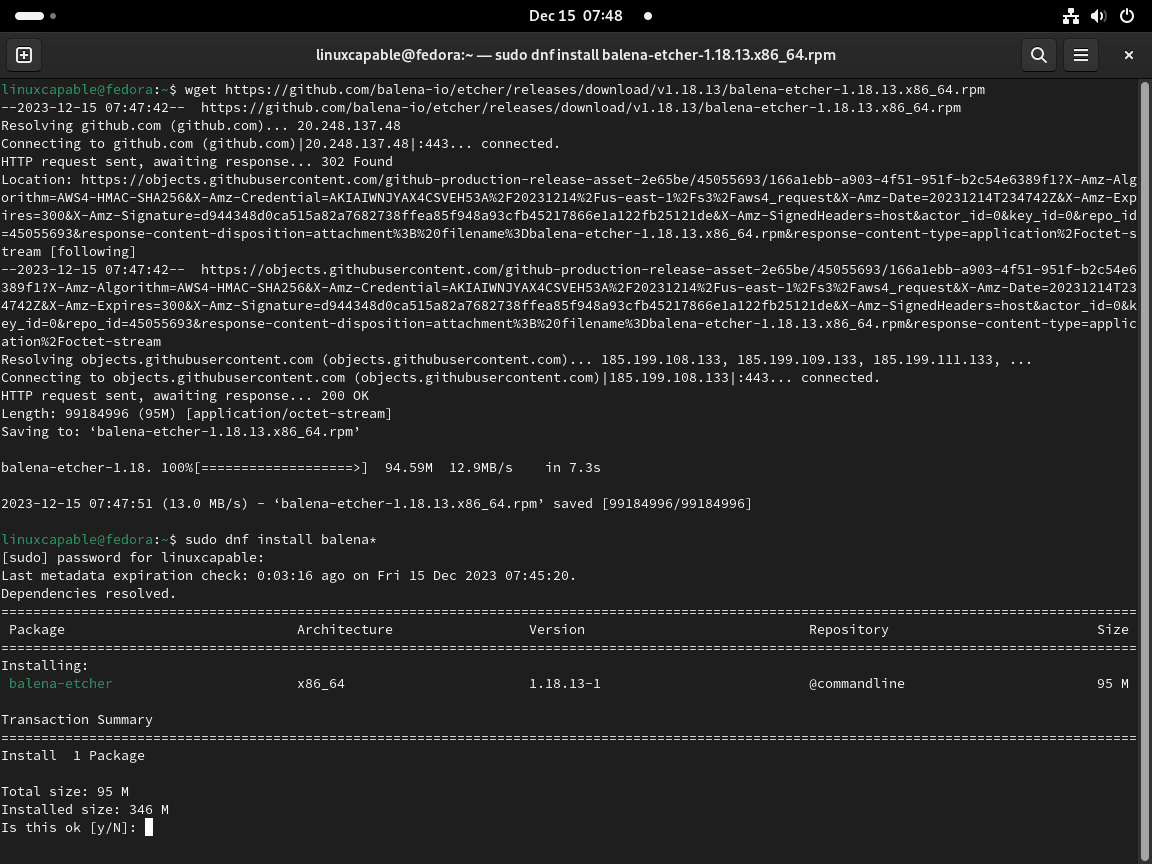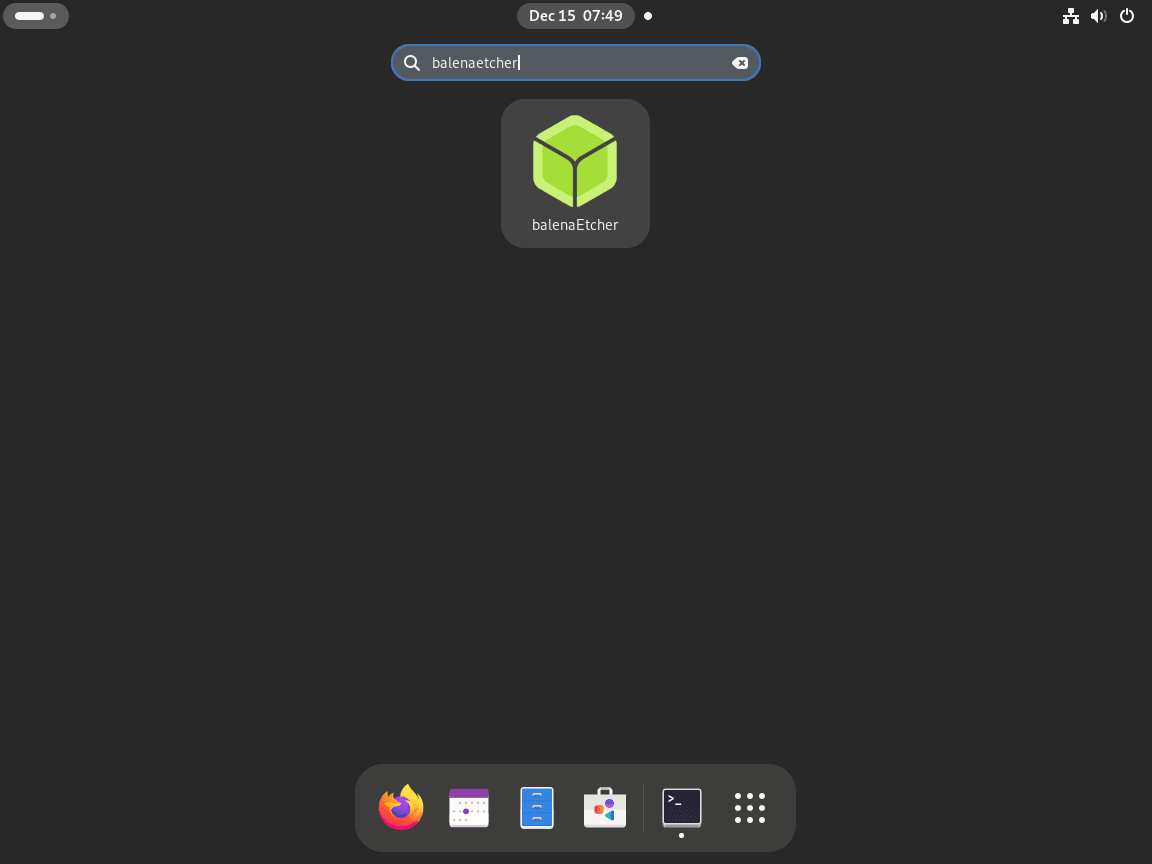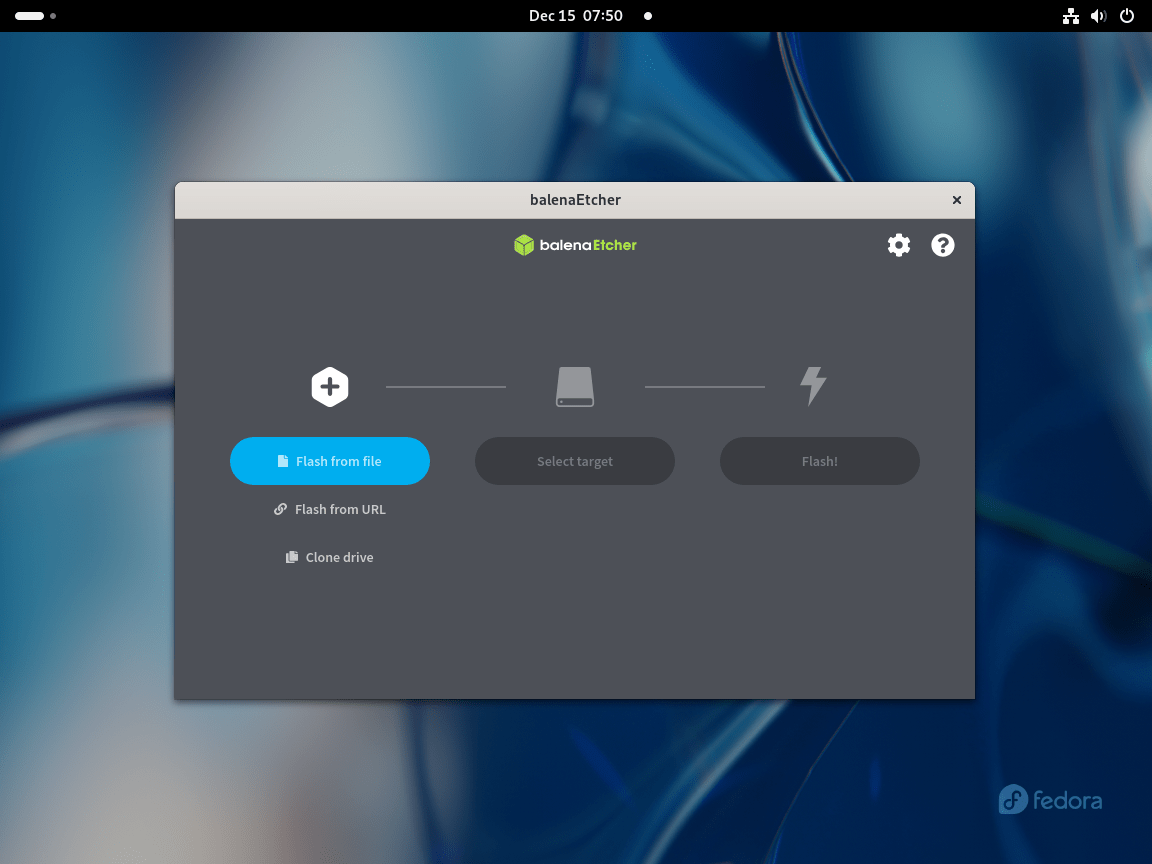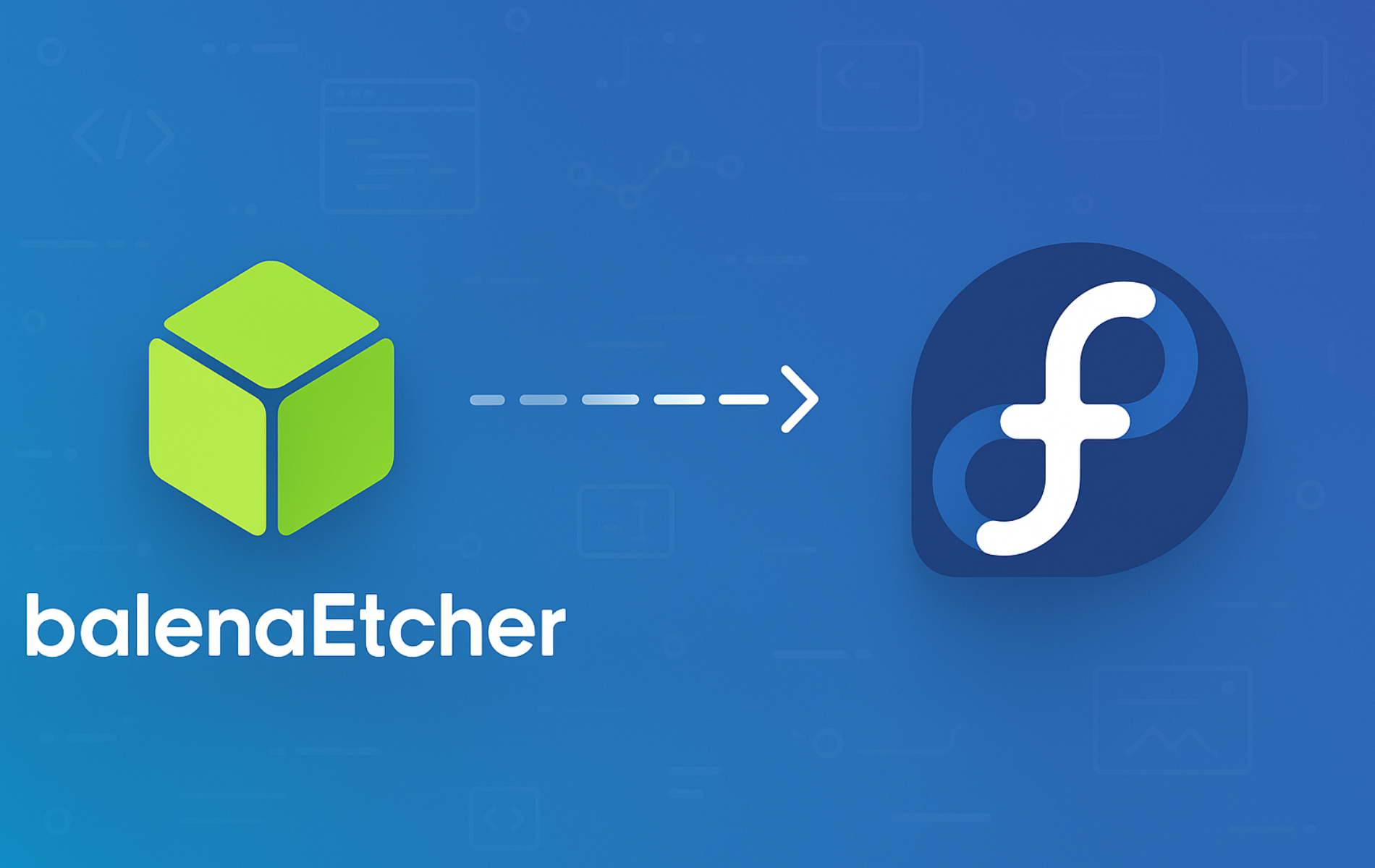balenaEtcher simplifies creating bootable USB drives and SD cards by safely flashing ISO and IMG files with built-in verification. This guide shows you how to download, install, and manage balenaEtcher on Fedora Linux using the official RPM package from GitHub releases. You will learn how to install the application, launch it from either the terminal or desktop environment, and keep it updated as new versions release. By the end of this guide, you will have a working installation ready to flash operating system images for Linux distributions, Raspberry Pi projects, or recovery tools.
balenaEtcher is an Electron-based application that balena distributes exclusively as pre-built packages for each platform. No official Flatpak, Snap, or distribution repository exists. The RPM download from GitHub releases is the recommended installation method for Fedora users. However, compiling from source is possible but impractical due to complex Node.js and Electron build dependencies.
Install balenaEtcher via RPM Download
Installing balenaEtcher on Fedora Linux requires downloading the RPM package from GitHub releases and installing it with DNF. Follow these steps to ensure a successful installation:
Update Fedora System
Before installing balenaEtcher, first update your Fedora system to ensure all existing packages are up-to-date. Run the following command:
sudo dnf upgrade --refreshTherefore, this step reduces the risk of conflicts during the installation process by ensuring your system has the latest updates.
Install wget Utility
The wget utility downloads files from the command line. Check if wget is installed on your system, and install it if necessary:
command -v wget || sudo dnf install -y wgetThis command checks for wget and installs it only if missing. Once wget is available, proceed to download the balenaEtcher package.
Download balenaEtcher RPM
Download the latest balenaEtcher RPM file automatically using the GitHub API. The command below detects the most recent version and downloads it:
VERSION=$(curl -s https://api.github.com/repos/balena-io/etcher/releases/latest | grep -oP '"tag_name": "v\K[0-9.]+') && wget https://github.com/balena-io/etcher/releases/download/v${VERSION}/balena-etcher-${VERSION}-1.x86_64.rpmThis command queries the GitHub API to fetch the latest release tag, extracts the version number, and constructs the download URL automatically. The RPM file is approximately 122MB in size and takes a few minutes to download depending on your connection speed.
If you prefer to download a specific version manually, visit the balenaEtcher GitHub releases page and copy the direct link to the RPM file for your desired version.
Install balenaEtcher via DNF
After downloading the RPM file completes, proceed to install balenaEtcher using DNF. The command below installs the downloaded package:
sudo dnf install ./balena-etcher-*.rpmDNF automatically resolves and installs required dependencies (approximately 302 packages on a minimal Fedora installation). Additionally, the ./ prefix tells DNF to install from a local file rather than searching repositories.
During installation, DNF may display a warning about skipping OpenPGP checks for packages from the commandline repository. This is expected behavior when installing local RPM files and does not indicate a security issue with the official balenaEtcher package.
Verify balenaEtcher Installation
Finally, confirm that balenaEtcher installed successfully by checking the package status:
dnf list installed balena-etcherInstalled packages balena-etcher.x86_64 [version]-1 @commandline
The output confirms the installed version and shows that the package came from a local file (@commandline). The balenaEtcher binary installs to /usr/sbin/balena-etcher and is immediately available for use.

Launching balenaEtcher
Once balenaEtcher is installed, launch it using either the terminal or the Fedora desktop environment. Both methods open the same graphical interface for flashing images to USB drives.
Launch balenaEtcher from the Terminal
Open a terminal and run the following command to start balenaEtcher:
balena-etcherThe application window opens immediately, displaying three main options: Select Image, Select Target, and Flash. The binary installs to /usr/sbin/balena-etcher, which is included in your system PATH by default.
Launch balenaEtcher from Applications Menu
Alternatively, if you prefer using the Fedora desktop environment, follow these steps:
- Click on Activities in the top-left corner of the screen.
- Select Show Applications to display all installed applications.
- Use the search bar or scroll through the application menu to locate balenaEtcher.
- Click on the balenaEtcher icon to launch the application.
Once launched, the application is ready for use, and you can begin flashing image files onto USB drives.

First-Time Tips with balenaEtcher
Get started with balenaEtcher using these practical tips:
Navigating the Interface
- Explore the clean interface to locate the main functions:
- Select Image: Pick your
.iso,.img, or other supported image files. - Select Target: Choose the correct USB drive.
- Flash!: Begin creating your bootable drive.
- Select Image: Pick your
Image Selection and Verification
- Always choose the correct image file for your needs. BalenaEtcher supports
.iso,.img, and compressed formats. - Before flashing, always verify the image’s integrity using a checksum tool to ensure reliability.
Drive Selection Safety
- Double-check your target drive to avoid accidental data loss.
- BalenaEtcher’s built-in safety features help validate drive selections automatically.
Customization Options
- Similarly, access the settings menu to tweak notifications, enable error reporting, or configure auto-unmount options for smoother workflows.
Advanced Features for Power Users
- Automatic Validation: Ensure your bootable drive is ready with built-in verification.
- Multi-Write: Flash multiple USB drives at once to save time.

Troubleshooting Common Issues
If you encounter problems with balenaEtcher, these solutions address the most common issues reported by users.
USB Drive Not Detected
If balenaEtcher fails to detect your USB drive, the issue typically involves permission restrictions or device recognition. First, verify the USB device is connected and recognized by the system:
lsblkNAME MAJ:MIN RM SIZE RO TYPE MOUNTPOINTS sdb 8:16 1 14.9G 0 disk
The output shows your USB drive (typically sdb, sdc, or similar). If the drive appears in lsblk but not in balenaEtcher, your user account likely lacks permission to access the device. The best fix is to add your user to the disk group for permanent access:
sudo usermod -aG disk $USERYou must log out and back in for this change to take effect. If you need immediate access without logging out, you can try running balenaEtcher as root, though this may fail on default Wayland sessions:
sudo balena-etcherApplication Fails to Launch
If balenaEtcher does not start when clicked from the applications menu, launch it from the terminal to see error messages:
balena-etcher 2>&1 | head -20Common errors typically include missing library dependencies or graphics driver issues. If you see library errors, then reinstall balenaEtcher to restore any corrupted files:
sudo dnf reinstall balena-etcherGPG Signature Warning During Installation
When installing the RPM file, DNF displays a warning about skipping OpenPGP checks:
Warning: skipped OpenPGP checks for 1 package from repository: @commandline
This warning appears because you are installing from a local file rather than a configured repository. The warning is expected and does not indicate a security problem with the official balenaEtcher package downloaded from GitHub releases. Furthermore, DNF cannot verify signatures for local RPM files unless you manually import balena’s GPG key, which is not necessary for one-time installations.
Flashing Process Fails or Hangs
If the flashing process fails midway or appears to hang, the USB drive may have hardware issues or insufficient write speed. Test the drive’s health and verify it is not write-protected:
sudo badblocks -v /dev/sdXReplace /dev/sdX with your actual device identifier from lsblk. In addition, ensure your ISO or IMG file is not corrupted by verifying its checksum against the official source before attempting to flash again.
Writer Process Ended Unexpectedly
Some users encounter an error message stating “The writer process ended unexpectedly” after balenaEtcher completes flashing. Despite this error, the USB drive often works correctly. Therefore, to verify the flash succeeded, check the USB device manually:
sudo fdisk -l /dev/sdXReplace /dev/sdX with your USB device identifier. If the partition table shows an ISO9660 filesystem, the flash completed successfully despite the error message. Test the USB by attempting to boot from it; in most cases reported by Fedora users, the media works correctly even when balenaEtcher reports this error.
Windows Corrupts USB After Flashing
When creating bootable USB drives on Windows, never reconnect the USB to your Windows machine after flashing completes. Windows automatically writes additional files to the USB drive when it detects new media, which corrupts the bootable image and causes media check failures during installation. However, this is a well-documented issue that affects all USB writing tools when used on Windows, not just balenaEtcher.
If you accidentally reconnected the USB to Windows after flashing, then reflash the drive completely and eject it immediately without allowing Windows to access the device again. The corruption typically causes media checks to fail at exactly 4.8% during Fedora installation, though the installation may still succeed if you skip the media check step.
Updating balenaEtcher
Because balenaEtcher does not maintain a Fedora repository, updates require manually downloading and installing the latest RPM package. First, check your currently installed version:
dnf list installed balena-etcherInstalled packages balena-etcher.x86_64 [version]-1 @commandline
Next, download and install the latest version using the automated command from the installation section:
VERSION=$(curl -s https://api.github.com/repos/balena-io/etcher/releases/latest | grep -oP '"tag_name": "v\K[0-9.]+') && wget https://github.com/balena-io/etcher/releases/download/v${VERSION}/balena-etcher-${VERSION}-1.x86_64.rpm
sudo dnf install ./balena-etcher-*.rpmDNF automatically upgrades the existing installation to the newer version. The automated command always fetches the latest release, eliminating the need to manually check version numbers. Checking for updates quarterly ensures you benefit from bug fixes and new features.
Removing balenaEtcher
If you no longer need balenaEtcher, remove it using DNF:
sudo dnf remove balena-etcherThis command removes the balenaEtcher package and its dedicated dependencies. Meanwhile, verify removal by checking the package list:
dnf list installed balena-etcherError: No matching Packages to list
The error message confirms that balenaEtcher is no longer installed on your system. DNF automatically removes the package but leaves shared dependencies that other applications may use.
Useful Links
Explore these resources to expand your Fedora Linux knowledge and troubleshoot system issues:
- balenaEtcher GitHub Repository: Access the source code, report issues, and check for new releases.
- balenaEtcher Releases Page: Download the latest RPM packages and review version changelogs.
- balenaEtcher Community Forums: Ask questions, share experiences, and connect with other users.
- Install Firewalld on Fedora: Configure firewall rules to control network access on your Fedora system.
- Install Docker on Fedora: Set up containerized environments for testing and development.
- Install Git on Fedora: Version control setup for software development and collaboration.
- Install WoeUSB on Fedora: Alternative tool for creating Windows bootable USB drives from ISO files.
Conclusion
You now have balenaEtcher installed on Fedora Linux via the official RPM package from GitHub releases. This guide covered downloading the latest version with wget, installing with DNF, verifying the installation, and troubleshooting common USB detection issues. To keep your installation current, check the GitHub releases page quarterly and manually install updated RPM packages using the same DNF commands. Finally, for related tasks, consider installing WoeUSB for Windows USB creation or configuring firewalld to control USB device access on multi-user systems.

